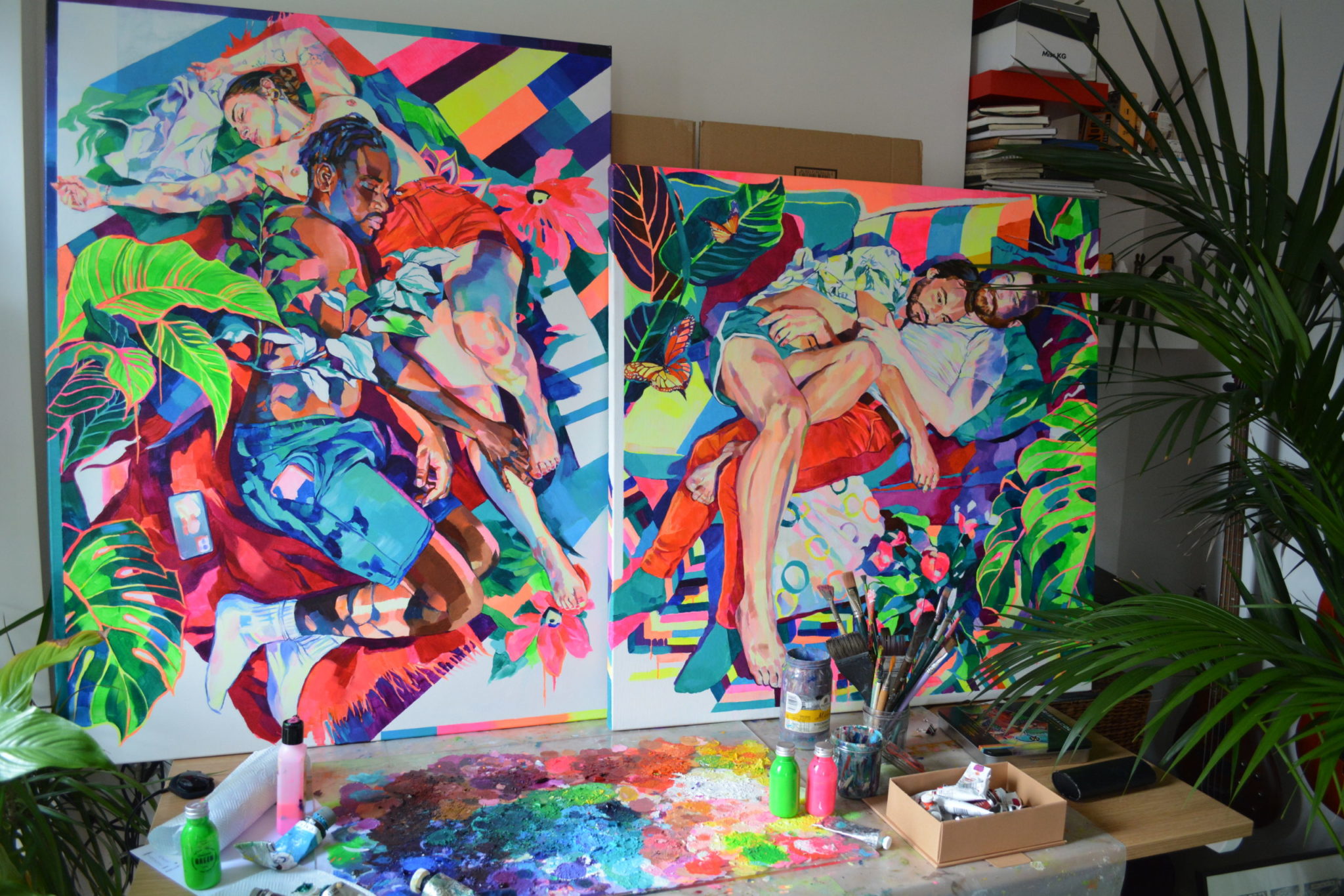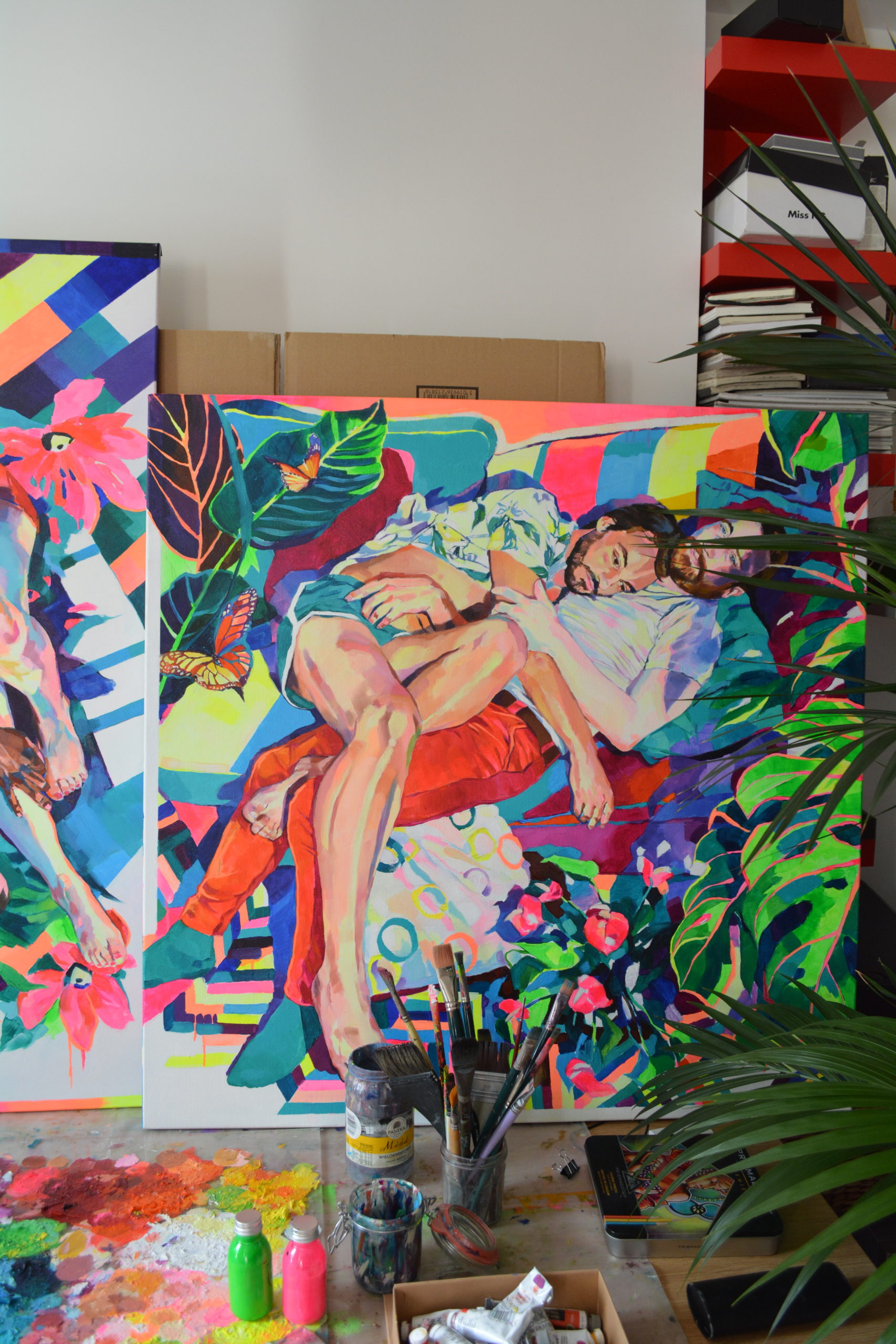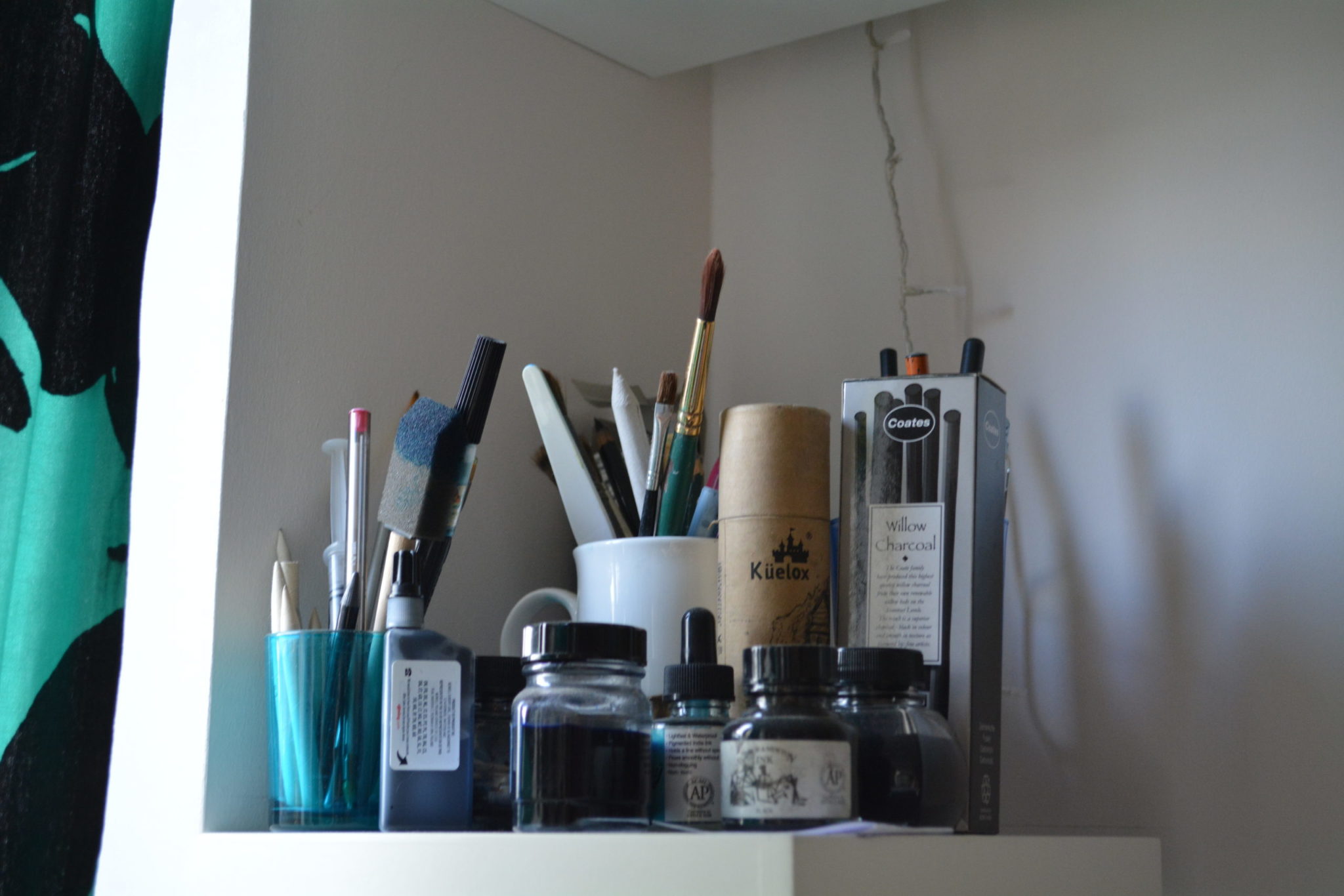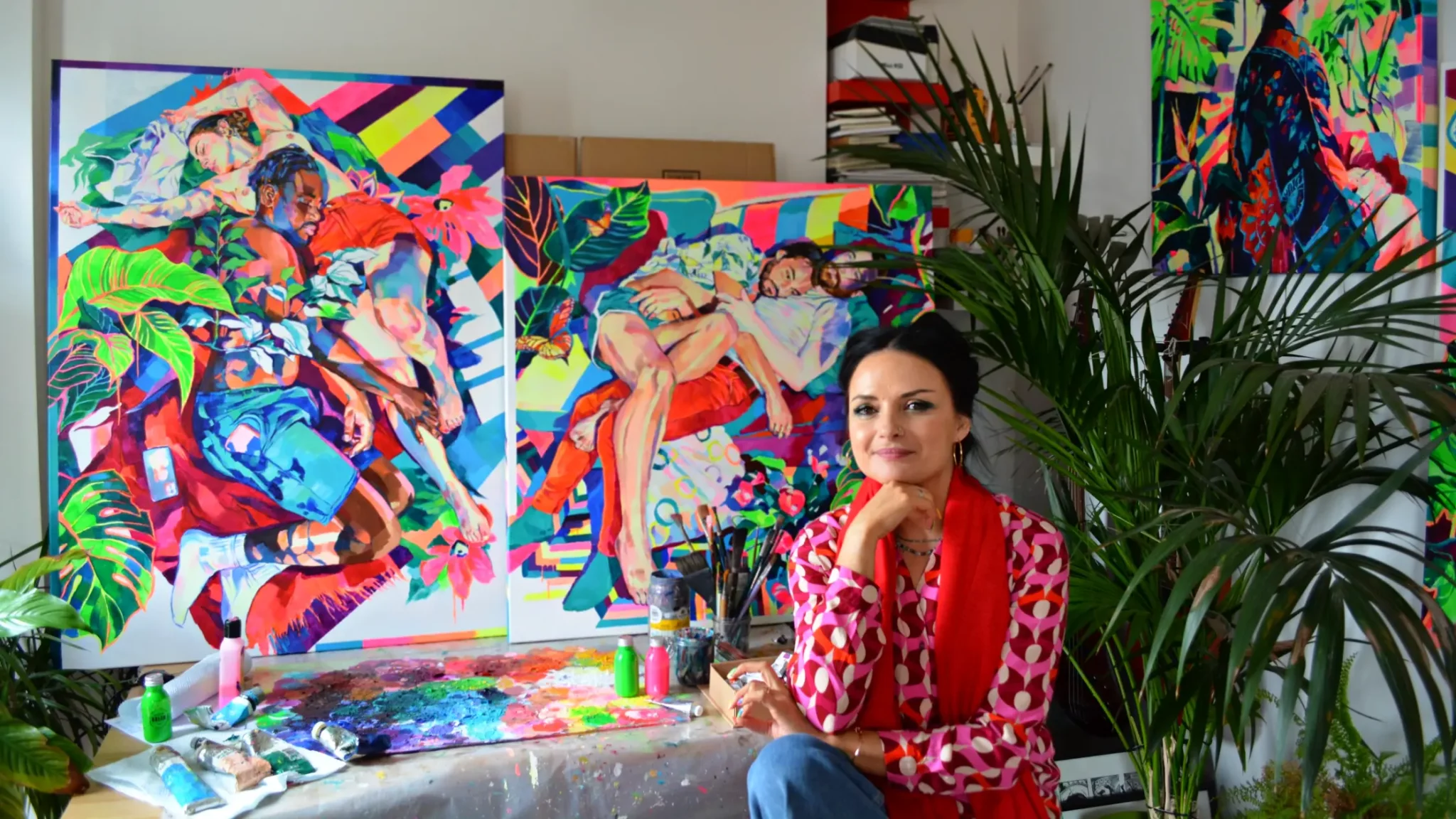By Zoë Goetzmann (@byzoesera)
Interview with Joanna Pilarczyk – Contemporary Artist
This week we visited Joanna Pilarczyk’s (@joannapilarczyk) studio in North London – a colorful neon oasis.
Joanna is a contemporary figurative painter. She works predominately in oils, as well as in acrylics and in spray paint. Joanna was born in Poland. She studied at the Art University in Zielona Gora where she holds a degree in Visual Arts and in Art Education.
She has exhibited her work internationally in group and solo shows in London and in the United States. Joanna has displayed her work at Saatchi Gallery’s Start Art Fair and The Other Art Fair.
She recently had a solo show with Oink Gallery, and Joanna also won the Boynes Monthly Artist Award and was a Women United Art Prize finalist in 2021 and 2022. She has been featured in art publications such as All She Makes, Art Seen, Create! Magazine and Women United Art Magazine (to name and to list a few).
Her work explores subjects related to nature and intimacy. In this interview, we talk all about her process, and how she works with her subjects: exploring topics such as diversity, representation, and racism when it comes to telling the stories behind the figures in her works.
We also speak about her artistic inspirations (how this changed pre and post-pandemic) and advice that she would give to other emerging artists embarking on their creative journeys.
You can listen to the unabridged version of the interview via our podcast.

Zoë: So, thank you Joanna, for taking part in this interview. I’m excited to talk to you about your ‘Artist’s Journey,’ and your career, so far.
So, to begin with, I like to start every interview with I call an ‘Artist Story’… Instead of saying: “How did you become an artist? How did you get here?”
Could you kind of tell us your ‘Artist Story’ and what led you to become an artist from art school, or, you know, from [your] training?
Joanna: Okay. It was a pretty easy decision. Like most of us, I knew I would be an artist as I was very creative from an early age.
I should mention that in fact, I have a twin sister. For us both, it was very easy to communicate with other children through art.
I mean, with people generally, as we both were very shy. From the very beginning, when we were around four years old, our uncle taught us how to draw and paint our favourite characters from children’s animations.
And when we were in kindergarten, we were the best in art. Every kid asked us to draw for them and wanted to learn from us.
Zoë: That’s so early [laughs]. It started that early as well.
Joanna: My parents knew immediately that it was worth it to sign us into some after-school art classes. We were lucky to know a lovely person – an artist – in our hometown.
She worked at the local community centre. So, we started from five years old and took those classes for around 15 years. Even in primary school, I was lucky to have excellent teachers. At that point, I was preparing with my sister for the Art College exams.
In the summertime, we took the opportunity to go to Art Planners, which was organised through the community centre. It was cool to meet other artists from Germany, France, and Poland and practice with them.
Most of the attendants were older and more advanced. So, it was even better for us to learn a bit more about painting techniques or some other different stuff.
We started Art College when we were both 15 in a different city, so we had to move out from our home […] It was fun.

Zoë: So you and your sister both went to the same Art College? Oh, wow. And you’re [both] identical?
Joanna: Yes. We’re both identical.
Zoë: Okay, so both of you were gifted in the arts. Is she still an artist?
Joanna: She’s still an artist but now works as a tattoo artist. She always was more interested in realistic, almost hyper-realistic, drawing and painting.
And my way of artistic expression was more impressionistic and expressionistic [that kind of style].
Zoë: I was wondering if your styles ever differed [or differ]?
Joanna: When we were teenagers and students at Art College, the teachers at the beginning, especially in the first year, had difficulty recognising whether [my twin sister] or I painted one of the paintings or drawings or whatever.
So at the start, our styles were very similar for a long time. And then we started taking directions when we were older.
Zoë: So what happened and/or where did you go after college [career-wise]?
Joanna: After art college, I had a two-year break. And I went to work briefly in Warsaw and wanted to work as a video game designer. I was into designing video game characters.
And at that time, I was in a relationship. I thought living in a bigger city would be a good idea. But after two years, I realized I needed to study.
I wanted to learn more about art generally. So I returned to West Poland and moved to Zielona Gora, where I continued my further art education. My friend studied his art education at the same University. He started two years before.
He told me that it would be a better opportunity for me to learn more about – for example, printmaking, sculpture, photography, multimedia, not only painting or drawing. This would be a better chance for me to try everything.
Through those five years, I was happy to work with excellent professors. But at the end of these five years, I decided to graduate with a diploma in Figurative Painting, specifically portraiture.
Zoë: Were you always a painter?
Joanna: Yes. I think painting was the most important medium for me, because I love to express myself in colour.
Zoë: Can you tell me a little bit about your practice (as we sit with all of your paintings). There’s so much colour surrounding us in this studio.
Joanna: About my artistic practice, I think it is a pretty important fact to point out that I grew up in the ’80s in Poland when the country was controlled by the Soviet Union.
As a child, everything was kind of ‘grey’ for me in our country. I couldn’t obtain colourful crayons or markers or paints. So we had minimal supplies.
And I remember, around the ’90s, when I was around 15, I started watching American movies and TV shows. I really loved Miami Vice, which was all about neon’s, as you can imagine.
I was so fascinated by this American world. It was so different from Poland. But still, for a long time, I couldn’t achieve this colourful aesthetic in my paintings because of the limitation of materials. It was a problem for me.
When I moved here to London 12 years ago, I was suddenly surrounded by people from all over the world, with different personalities and skin colours.
I also could discover other materials to work with and achieve my creative vision. I created my own visual style.
Zoë: What mediums do you work with predominantly?
Joanna: Primarily, it’s always oil paint because I like how the oils mix. I love the smell. The texture of oils. I liked the fact that I can paint in oils, almost like in watercolours. When I realized I needed a more vivid colour palette, I started experimenting with adding acrylics to oils, which is quite unusual.
Everyone is saying: “You can’t mix oils with acrylics…” But if the acrylics are of good quality, it is possible.

Zoë: I love that you said you love the smell of oils. I also do love the smell as well …
Joanna: I love it. The smell. The oily texture. The brushes. They are so different. I teach watercolour techniques, and I still like to paint with inks on paper, but the oils’ vibrance and texture are the best for producing colourful paintings.
That’s the most important for me and my artistic practice.
Zoë: What do you like most about figurative painting? And how do you choose the subjects that you paint?
Joanna: When I was at University, I usually painted my friends, which was the obvious choice. I like to get to know someone more and tell the story behind their faces. With my friends, we would discuss their lives, problems, achievements, etc.
When I moved to London, I was overwhelmed with this vast multicultural environment: different people and skin tones (etc.). It was very inspiring for me. Fashion became another form of inspiration. My partner is a fan of video games.
And as a motion graphic designer, he works with animation a lot. It gave me the idea of incorporating these pictures into my paintings. Especially the neon colours and the various textures. I should mention ‘the pandemic time’ because it was slightly different.
I couldn’t work with people. So I started focusing for the first time on myself and my husband as the subjects of my paintings. It was terrifying at the beginning. I really didn’t like the idea of painting myself.
But after a few self-portraits, I’ve become used to it. I distanced myself from who I am. Mainly if I painted my body, I felt more like I was painting some other woman who wasn’t me. It was a different story when I painted my husband or my cats.

Zoë: What’s your least favorite thing maybe about the art world [about being an artist or about being in the art world]?
Joanna: I think it’s all about – unfortunately – money. Like in every business. I don’t like this. [I] probably wasn’t aware when I was in Poland, how important is to pay for everything.
It’s not for free: the exhibitions, the open calls. Everyone has to realise [these facts]. People who don’t appreciate artists [should realize that it is a] 24-hour job: doing business, paying for everything, planning everything, and being [staying] mentally sane.
There [are a lot of] dark areas, which I don’t like, but we kind of deal with it.
Zoë: Is there anything that you wish that people knew about being an artist?
Joanna: I think they should just know that from the early hours when we wake up, it’s all about thinking about art. And the reason why we wake up is to create.
It’s not [just] a hobby. It’s not like: “Oh, I’m leaving and doing this job, but from time to time, I’m going to paint this and I want $10,000 for this or whatever.”
It’s very hard work, and a learning process […] that should be appreciated.
Zoë: Definitely. I think that’s important to know. And then: from ‘Artist-to-Artist,’ is there any advice that you would give to emerging artists embarking on their creative journeys?
Joanna: Be honest. Be yourself. Don’t be afraid to take part in [art] competitions, even if [you might] fail, it is worth it.
Because people: [i.e. curators] see those paintings or sculptures, so [artists] have to push [through] the door and do everything [they can] to show our work.
Zoë: Is there any advice you’d give to artists about confidence [from pricing artwork to submitting or exhibiting artwork]?
Joanna: Everyone has different spectrums [in terms of how they] think about the creative process.
[With] pricing, I [tend to] think about how long it [took] me to learn about art: 10 years of study plus some other expenses […], doing workshops, courses, coaching with art curators. Of course, the time [it takes] creating [a] painting, which for me takes few weeks [or] usually [a] few hours every day. The pricing of materials [should also be included in the artwork price].
I was in the situation when [a] gallery from Colorado [in the early part of my career], they told me [they were going to sell my painting] for 4000 pounds. And at that point, my pricing was much lower. It was about 2000, I guess.
Then, in [this] situation, when they [displayed it] in [the] gallery space, I had to raise the prices everywhere and it was a problem because for a long time, I wasn’t able to sell.
I felt like it was a bit too quick, too high, you know, so [artists] have to be careful about [these pricing level changes].
And [I’ve] had this conversation a lot with Daniel Freaker (@freakerstudio) whose point of view is completely different: he suggests starting from a much lower price, because it’s better when the potential [first] collectors have your painting[s] in their home already for [a] cheaper price, because they will be back later for more. It’s better to build up the price slowly, in his opinion. It’s very easy to make mistake[s] about [this process].
I felt like I did something which I shouldn’t, I lower the prices after the situation and wait.
Zoë: What’s the best thing about actually being an artist in London? About this community here?
Joanna: I think that the best part is that we have so many opportunities here and even if starting from the local cafe, showing everywhere and just build[ing] up the visibility, building up [your Artist] CV [it] is so important. Definitely in London, I’m happy to connect with more people, especially after the art fairs. For example, [after The Other Art Fair], I was invited [to participate in a] solo show with Oink Gallery.
So, it is important to be in [places] like London or Paris probably where [these opportunities are] possible.
Zoë: How much networking do you [per] via in-person and on instagram?
Joanna: Once the artist starts to exhibit and [participate in] art fairs, it’s important to [participate] regularly. Instagram, of course, is very important: posting (not like [a] crazy amount), because I’m not that kind of person, but maybe twice a week or three times a week (doing some IG Stories). I usually promote my post[s] also on Instagram to get more followers.
This is the way how it works and [it’s] worth it.

Zoë: And for artists who are just starting in the art fair circuit and landscape, what’s the best way to maximize your time there? What’s the best strategy, because it’s quite costly for some young, emerging artists?
Joanna: I think, first of all post about it [the art fair] a few weeks earlier and show [a few] new works, which [you] are going to exhibit and I think just talking to people.
It’s so important to talk face-to-face with everyone at [art fairs] […] It’s so important to talk to everyone and be very open and very honest about what you do […]
Zoë: Looking back, what advice would you give to younger Joanna (five-year-old or Art School Joanna) on your artistic career?
Joanna: The advice to myself when I finished that university [is that] I should have moved out earlier, or if not, if I [were to have stayed] in Poland, I should connect with people via social media much earlier: [with] other artists, art curators, do research, connect with platforms for my art could be promoted.
I’m talking now to Polish artists who are [still] in Poland: take your time, learn English, and connect with other worlds online. Make sure to have [you work featured in] publications [i.e. in art magazines], so people can learn about you [and] your art.
Zoë: Be written about and grow your community now [at this moment]. Thank you so much Joanna for taking part in this interview. This has been really great. We’ve had a nice, literal sit-down conversation and discussion.
Joanna: On the carpet in my living room/studio!
Zoë: And there’s so much colour. That’s why it’s such a happy place.

